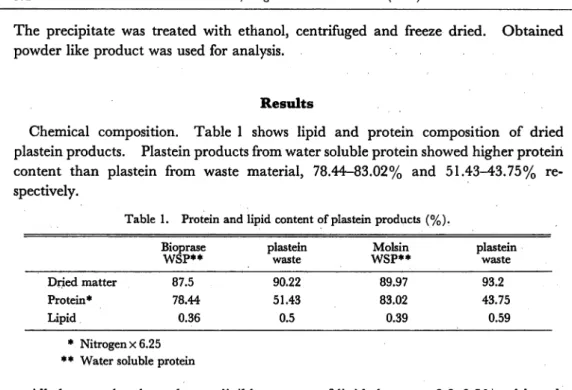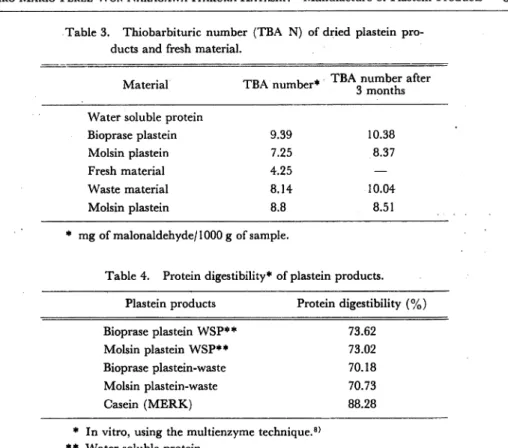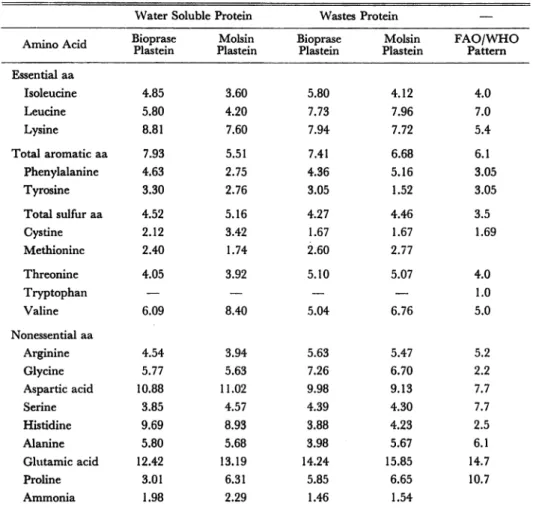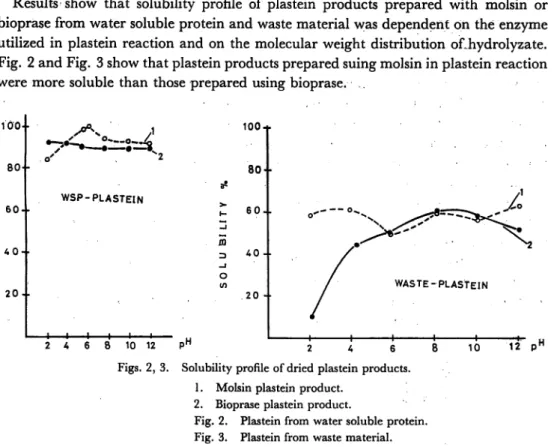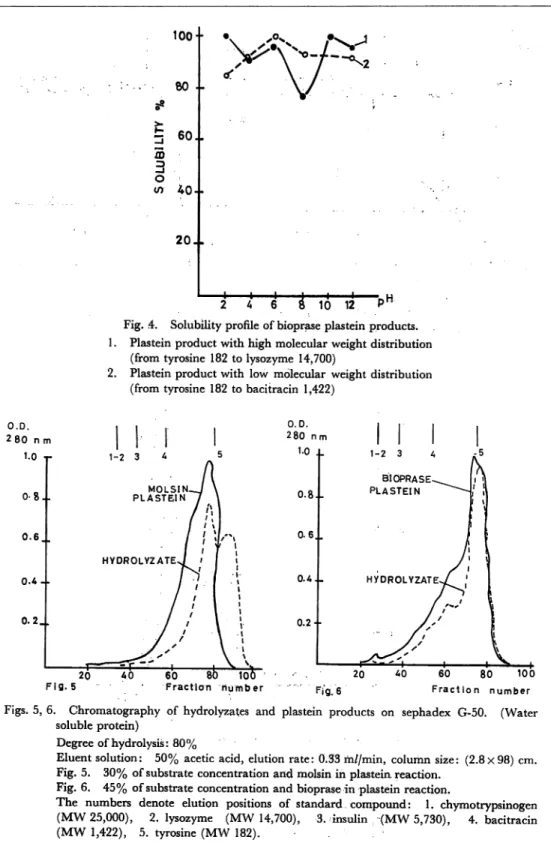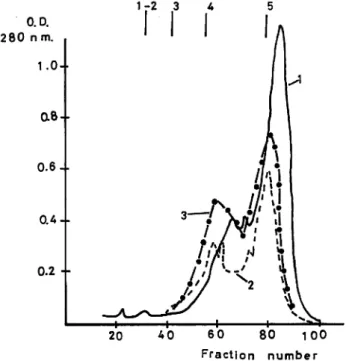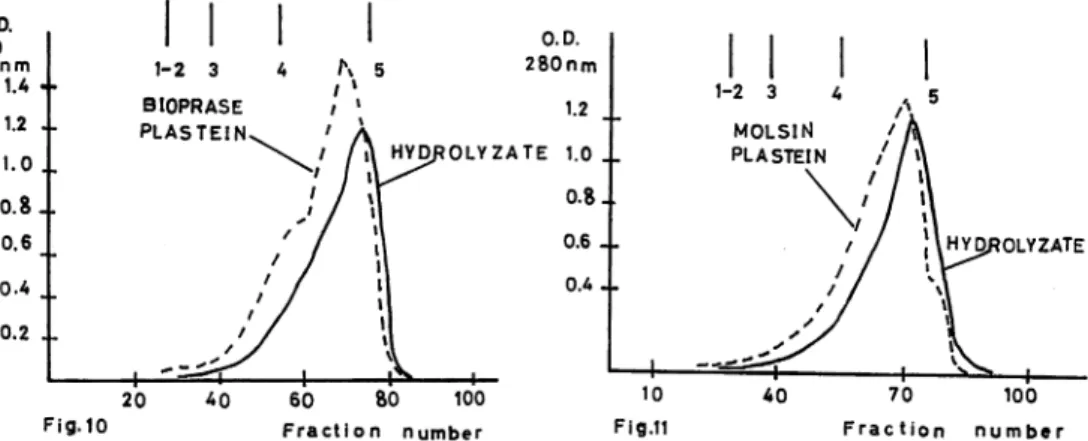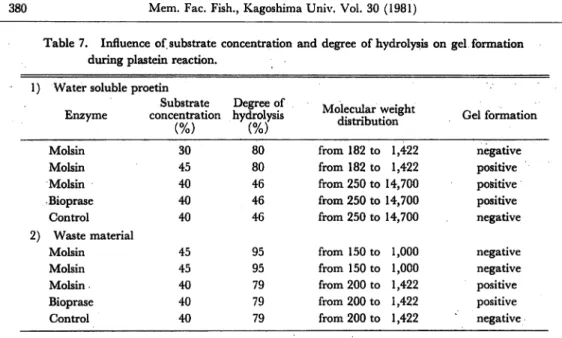Approaches to the Use of Plastein Reaction in
Oily Fish : Preparation and Characterization
of Plastein Products
著者
OOSHIRO Zentaro, MARIO Perez Won, NAKAGAWA
Susumu, ITAKURA Takao, HAYASHI Seiichi
journal or
publication title
鹿児島大学水産学部紀要=Memoirs of Faculty of
Fisheries Kagoshima University
volume
30
page range
369-382
別言語のタイトル
酵素処理による多脂魚肉タンパク質の分解と組立 :
プラスティンの調製とその性質
Vol.30 pp. 369-382 (1981)
Approaches to the Use of Plastein Reaction
in Oily Fish
—Preparation and Characterization of Plastein Products—
Zentaro Ooshiro, Mario Perez Won, Susumu Nakagawa,
Takao Itakura and Seiichi Hayashi*
Abstract
Plastein reaction was applied to watersoluble protein and waste material ofoilyfishes (sardine,
Sardinops melanosticta). Formed products were treated with ethanol and normal hexane then
dried. Chromatographic behavior, lipids content, total protein content, protein digestibility, solubility, hydration capacity, thiobarbituric number and aminoacid content of dried products were studied. Sephadex chromatography of end products and hydrolyzed solution showed onlya slight change in molecular weight distribution. Driedproducts had highproteincontent, low lipid content (about 0.3-0.5%), nice protein digestibility (75%), low thiobarbituric number and high proportion content of essential amino acids. Protein recovery was 67.5% for water soluble protein and 28% for waste protein. It was possible to get gel like products.
An underutilized resource of protein is present in water soluble protein and waste
material of oily fishes, but the main problem is to develop adequate technique for the
recovery of this resource.
Nowork have been reported until now in the use ofplastein
reaction in water soluble protein and waste protein of oily fishes.
Plastein reaction involved the enzymatic hydrolysis of proteins into small molecular
polypeptides and the rearrangement of these peptides, intonew protein-like substance,
by transpeptidation, noncovalent bonds, hydrophobic interaction1) or condensation
reactions2), using enzyme (protease) as a driving force.
One problem related with the use of enzyme in food industries is the cost of the
enzyme.
In this report were used two microbial proteases Molsin (from Aspergillus
saitoi) and Bioprase (from Bacillus subtillis), which have been reported by some
authors to present a nice plastein productivity3). And also microbial proteases are
cheaper than animal or plant proteases.
The present study was done to determine the feasibility of utilize plastein reaction
in water soluble protein and waste material of oily fishes, and evaluate the character
istics of formed products.
Gel chromatography was also performed to determine,
the molecular weight distribution of plastein products and hydrolyzed solutions.
Materials and Methods
Methods of Evaluation.
Protein determination were based on Kjeldahl nitrogen X6.25, moisture was
determined by heating to a constant weight in a drying oven at 135°C for 2 hours
as described by AOAC4). The method of Bligh and Dyer5) was used for total lipids.
Amino acids were analyzed with a Hitachi automatic amino acid analyzer, model
034, as described by Moore et al.6).Tryptophan was determined by alkaline hydrolysis procedure, as described by
Noltman et al.7)
Cysteine was analyzed by performic acid oxidation method as de
scribed by Moore et al.8).Rancidity was determined using the 2-Thiobarbituric acid method (TBA), as
described by Shibata et al.9) Results were expressed in TBA number according to
Sinnhuber et al.10).
In vitro digestibility was determined as described by Hsu et al.11)
A multienzyme
system was added to protein suspension at pH 8.0 and the drop in pH was recorded
for 10 min. Merk Hammarsten casein was used as standard substrate.At first was used pepsin as described by Oshima12), but the results were in agreement
with multienzyme method.
Solubility profile of plastein products was determined, dissolving 1 g of dried pro
duct in solutions at various pH, from pH 2 to 12,then holding the samples at the above
mentioned pH for 2 hours and centrifuged at 5000 rpm for 15 min.
Protein contents in supernatant and precipitate were determined by Biuret reaction
as described by Ooshiro.13*14)%Solubility= mS of Protein in suPcrnatant x100
mg of total protein
Molecular weight distribution was determined by gel chromatography as described
by Hofsten et al1)., using Sephadex G-50 equilibrated with 50% v/v acetic acid and
eluted with the same solvent. Fractions of constant volume, usually 6.4 ml, were
collected and the molecular weight distribution of plastein products and hydrolyzed
solutions, was determined in the eluates measuring the absorbance at 280 nm.Degree of hydrolysis was determined as described by Yamashita et al.15)
Hydrolyzed solution was mixed with an equal volume of 20% trichloroacetic acid,
held for 2 hours at room temperature and filtered.
Degree of hydrolysis is based on
the ratio of nitrogen amount in 10% TCA soluble fraction vs. that in whole
hydro-lyzate.
Hydration capacity was determined as described by Bryant et al.16), 0.2 g of dried
plastein product was hydrated with 15 mlofsolution ofvarious pH, from pH 2 to 12,
for 2 hours, then centrifuged at 2400 XG for 30 min and the supernatant was carefully
removed with a pipette. Hydration capacity was calculated substracting to the initial 15 ml, the volume found in the supernatant.
Plastein productivity was measured only as an index, according to the method re
ported by Yamashita et al.17).
Recovery was calculated from the initial protein content in water soluble protein
or waste protein and the protein content in dried plastein products.
Result was
presented as %.
Experimental Procedure.
Fresh sardine was obtained from Fish Market and freezed until use. Frozen
sardine was defrosted in current water and immediatly processed. From sardine
were obtained fillets and waste material such as head, visceras etc.
Water soluble protein extraction. Fillets were minced in automatic chopper, mixed with twice volume of water (w/v), homogenized with Ultra Turrax homogenizer for 3 min, held at 3°C with magnetic stirring for 1 hour, and centrifuged at 5000 rpm for 20 min. Supernatant was filtered with cotton used as a filter and this resultant solution was called Water Soluble Protein (WSP).
Waste material preparation. Whole sardine waste, head, visceras, and bones, was minced same as fillets and mixed with twice volume (w/v) of 0.24 N HC116) and homogenized with Ultra Turrax homogenizer. This preparation was used in the next step of hydrolysis.
Hydrolysis. The pH of water soluble protein was adjusted to 1.6 with HC1 solution, treated with pepsin (Wako Pure Chemical Industries, digestive power 1: 10,000) 2/100 (enzyme/protein ratio) at 37°C, with stirring for 24 hours. Neutralization was made adjusting the pH to 7.0 with NaOH solution. Cooled in a water ice bath and held at this condition for one night, then was centrifuged. Supernatant solution was filtered using cotton as a filter and this resultant solution was called hydrolyzed solution.
Concentration. Hydrolyzed solution was concentrated at 40-45°C in a rotary evaporator, until protein concentration became 30-45%. The concentration and hydrolysis of waste material was carried out same as was described for water soluble protein.
Plastein reaction. Concentrated solutions from water soluble protein and waste material were used as subtrates in plastein reaction. The substrates were incubated with Bioprase (Nagase and Co. Ltd. 10,000 PUN/g) or Molsin (Seishin Pharmaceutical Co. Ltd.), proteases obtained from Bacillus subtilis and Aspergillus saitoi respectively, under the following conditions, concentration of protein 30-45%, enzyme substrate ratio, 2/100, pH 6.03), incubation temperature, 37°C and incubation time, 24 hours without stirring.
Preparation of ethanol-normal hexane insoluble products. Each incubation mixture was treated with twice volume of ethanol, stirred and centrifuged. Precipitate was treated with twice volume of normal hexane at 70°C for 10 min and centrifuged.
The precipitate was treated with ethanol, centrifuged and freeze dried. Obtained powder like product was used for analysis.
Results
Chemical composition. Table 1 shows lipid and protein composition of dried plastein products. Plastein products from water soluble protein showed higher protein content than plastein from waste material, 78.44-83.02% and 51.43-43.75% re spectively.
Table 1. Protein and lipid content of plastein products (%).
Bioprase WSP** plastein waste Molsin WSP** plastein waste Dried matter 87.5 90.22 89.97 93.2 Protein* 78.44 51.43 83.02 43.75 Lipid 0.36 0.5 0.39 0.59 * Nitrogen x6.25
** Water soluble protein
All the samples showed a negligible amount of lipids between 0.3-0.5%, although lipid content of plastein from water soluble protein was less than plastein from waste material 0.36-0.39% and 0.5-0.59% respectively.
Lipids could be removed from water soluble protein by hydrolysis and plastein reaction only in 57.5%, for that reason was necessary to treat plastein products with normal hexane (Table 2).
Table 2. Lipids removal from fresh fish by plastein reaction, compared with n-hexane treatment.
Material Lipid content Efficiency***
(%) (%)
Fresh fish 12.0 —
Sample-1* 6.9 42.5
Sample-2** 0.36 97.0
* Dried plastein products without n-hexane treatment. ** Dried plastein products with n-hexane treatment.
*** Percent of lipids removal
Thiobarbituric acid number (TBAN), was low 9.39-7.25 for bioprase plastein and molsin plastein from water soluble protein respectively. After 3 months of storage either in plastein products from water soluble protein or plastein products from waste protein, only a slight change in TBA N was detected. The rate of oxidation during plastein preparation was very high (Table 3).
Table 3. Thiobarbituric number (TBA N) of dried plastein pro-ducts and fresh material.
Material TBA number* TBA number after 3 months
Water soluble protein
Bioprase plastein 9.39 10.38 Molsin plastein 7.25 8.37 Fresh material 4.25 — Waste material 8.14 10.04 Molsin plastein 8.8 8.51 * mg of malonaldehyde/1000 g of sample.
Table 4. Protein digestibility* of plastein products. Plastein products Protein digestibility (%)
Bioprase plastein WSP** 73.62
Molsin plastein WSP** 73.02
Bioprase plastein-waste 70.18
Molsin plastein-waste 70.73
Casein (MERK) 88.28
* In vitro, using the multienzyme technique.8)
** Water soluble protein.
is faster than during preservation. Table 4 shows in vitro digestibilities of plastein products using trypsin, chymotrypsin and peptidase11). Digestibility of plastein products prepared from water soluble protein were a little higher than those prepared from waste material, 73.62-73.02% and 70.18-70.73% respectively. All the samples examined showed a protein digestibility lower than standard Merk casein. Yamashita et al.19) reported similar digestibility value for plastein product obtained from soy bean. Is possible suggest same as Yamashita et al.19) did with soy plastein product, that water soluble protein plastein and waste plastein are applicable to food.
Amino acids content. Amino acids composition of plastein products from water soluble protein and waste material, prepared using bioprase and molsin was deter mined and presented in Table 5. The level of amino acids in plastein products made from water soluble protein and waste material of oily fishes approaches nearly to FAO/WHO (1973) pattern2**).
The limiting essential amino acids in WSP-plastein compared with FAO/WHO (1973) pattern20), were leucine, phenilalanine and tryptophan. In waste protein was tryptophan.
Molsin plastein products from water soluble protein and waste protein, were limiting in tyrosine. Molsin plastein product from WSP was limiting also in isoleucine. Molsin plastein products presented more limiting essential amino acids than bioprase
Table 5. Amino Acid Composition of Plastein products, FAO/WHO Provisional Pattern (1973) (grs. aa/100 grs.protein).29)
Water Soluble Protein Wastes Protein —
Amino Acid Bioprase
Plastein Molsin Plastein Bioprase Plastein Molsin Plastein FAO/WHO Pattern Essential aa Isoleucine 4.85 3.60 5.80 4.12 4.0 Leucine 5.80 4.20 7.73 7.96 7.0 Lysine 8.81 7.60 7.94 7.72 5.4 Total aromatic aa 7.93 5.51 7.41 6.68 6.1 Phenylalanine 4.63 2.75 4.36 5.16 3.05 Tyrosine 3.30 2.76 3.05 1.52 3.05 Total sulfur aa 4.52 5.16 4.27 4.46 3.5 Cystine 2.12 3.42 1.67 1.67 1.69 Methionine 2.40 1.74 2.60 2.77 Threonine 4.05 3.92 5.10 5.07 4.0 Tryptophan — — — — 1.0 Valine 6.09 8.40 5.04 6.76 5.0 Nonessential aa Arginine 4.54 3.94 5.63 5.47 5.2 Glycine 5.77 5.63 7.26 6.70 2.2 Aspartic acid 10.88 11.02 9.98 9.13 7.7 Serine 3.85 4.57 4.39 4.30 7.7 Histidine 9.69 8.93 3.88 4.23 2.5 Alanine 5.80 5.68 3.98 5.67 6.1 Glutamic acid 12.42 13.19 14.24 15.85 14.7 Proline 3.01 6.31 5.85 6.65 10.7 Ammonia 1.98 2.29 1.46 1.54
plastein products independently of utilized material (WSP or waste material). In view to study some nutritonial properties of plastein products, based on amino acids composition, Table 6 shows E: N (ratio of essential amino acids to non es sential amino acids), E: T (ratio of essential amino acids to total amino acids), E: P (ratio of essential amino acids to protein, 100 g), EAAI (essential amino acid index) is based on the ratios of the amounts of essental amino acids in a protein, relative to their amount in whole egg protein21). These results were analyzed as described by Sikka et al.23). Sikka et al.23) have suggested that E: N, E: T, E: P, and EAAI have some relation with the high PER (protein efficiency ratio) and NPR (net protein retention) found in FPC (fish protein concentrate) preprared from picked ribbonfish and catfish. Plastein products prepared with molsin, either using water soluble protein or waste material, showed lower E: N, E: P, E: T and EAAI than plastein products prepared with bioprase. Some relation exist between the amino acids
Table 6. E: N, E: P, E: T, ratios and EAAI (essential amino acid index) of plastein products.
Material E:N E:P E:T EAAI (%)
Bioprase plastein WSP** 0.75 0.42 0.421 82.29 Waste 0.764 0.43 0.433 84.7 Molsin plastein WSP** 0.624 0.38 0.384 75.13 Waste 0.718 0.42 0.418 83.69
* Nomenclature in the text ** See table 4
content of plastein products and the enzyme utilized in plastein reaction. Yamashita24-25) and Onoue19) reported that hydrolyzed solutions and plastein products showed some differences in amino acids content, specially in hydrophobic and hydro-philic amino acids. Some properties of plastein products, such as solubility is in fluenced by the enzyme utilized in the process26), and now the result suggest that the enzyme utilized in plastein reaction have also influence in nutritional aspects such as amino acids content and E: N, E: P, E: T, EAAI ratios in plastein products.
Hydration capacity. Plastein products didn't show a high hydration capacity value, compared with FPC prepared by low temperature alcohol treatment, which value was about 30 at pH 2.027). Bioprase plastein from water soluble protein showed the highest values at pH extremes 2 and 12. At those same pH bioprase plastein from waste material showed the lowest value. Results suggest that hydration capacity is more dependent of the protein material utilized in plastein reaction than the enzyme utilized in plastein reaction (Fig. 1).
Fig. 1. Hydration capacity of dried plastein products at various pH. 1. Bioprase plastein-water soluble protein.
2. Molsin plastein-waste
Although plastein products didn't present a high hydration capacity value, was
possible to get gel like products. Solubility profile of plastein products.
Plastein
products are defined as water insoluble products28'29).
Edwards et al26). reported
that the solubility profile of plastein products at various pH, was dependent on the
enzyme utilized in plastein reaction. Yamashita et al.23), prepared a glutamic acid
enriched plastein with great solubility, and these plastein products showed a low
molecular weight compared with standard plastein, being this one of the reason for the great solubility.Results show that solubility profile of plastein products prepared with molsin or
bioprase from water soluble protein and waste material was dependent on the enzyme
utilized in plastein reaction and on the molecular weight distribution of.hydrolyzate. Fig. 2 and Fig. 3 show that plastein products prepared suing molsin in plastein reaction were more soluble than those prepared using bioprase. .100
•7^*4
806 0 -WSP-PLASTEIN A0-. 2 0 . . 6 8 10 12 Figs. 2, 3. PH 2 4 6Solubility profile of dried plastein products. 1. Molsin plastein product.
Bioprase plastein product. 2. Fig. 2. Fig. 3. 100- 80-8* >• 1j 6 0 .
• ---^ ^^^
5 3 4 0 -/*
- J/
o 20 -/ WASTE-PLASTEIN H 1 1 1 1 fc-12 p^Plastein from water soluble protein. Plastein from waste material.
10
Solubility profile of low moleuclar weight distribution plastein products (molecular weight distribution from tyrosine 182 to bacitracin 1422) and high molecular weight distribution plastein (molecular weight distribution from tyrosine 182 to lysozyme 14.700) was different. At pH 8 and 4, high molecular plastein showed a markedly insolubility compared with low molecular weight plastein. Results are in agreement with the two above mentioned authors23-25) (Fig. 4).
Molecular weight distribution.of hydrolyzed solution adn plastein products, prepared from water soluble protein and waste material of sardine.
Fig. 5, 6, 7 and 8, show molecular weight distribution of hydrolyzed solution and plastein products prepared from water soluble protein of sardine. In Fig. 5 and 6,
20 FiQ.5 100--60 .-5 6o± 3 .3 o 20.. •°%
V'^-/^
-°^2 lo" 12-4- >H Fig. 4. Solubility profile of bioprase plastein products.1. Plastein product with high molecular weight distribution (from tyrosine 182 to lysozyme 14,700)
2. Plastein product with low molecular weight distribution (from tyrosine 182 to bacitracin 1,422)
60 80 100
Fraction number Fig. 6
60 80 100
Fraction number
Figs. 5, 6. Chromatography of hydrolyzates and plastein products on sephadex G-50. (Water
soluble protein)
Degree of hydrolysis: 80%
Eluent solution: 50% acetic acid, elution rate: 0.33 m//min, column size: (2.8x98) cm. Fig. 5. 30% of substrate concentration and molsin in plastein reaction.
Fig. 6. 45% of substrate concentration and bioprase in plastein reaction.
The numbers denote elution positions of standard compound: 1. chymotrypsinogen
(MW 25,000), 2. lysozyme (MW 14,700), 3. insulin (MW 5,730), 4. bacitracin
Pig. 7 60 100 Fraction number Fig. 8 60 100 Fraction number
Figs. 7, 8. Chromatography of hydrolyzates and plastein products on sephadex G-50. (Water
soluble protein)
Degree of hydrolysis: 46 %
Fig. 7. 40% of substrate concentration and bioprase in plastein reaction. Fig. 8. 40% of substrate concentration and molsin in plastein reaction
O.D. 280 n m. 1.0-. Q.B--0.6-. 0.4--0.2 -• 1 r2 3 4 20 40 60 80 100 Fraction number
Fig 9. Chromatography of hydrolyzate and plastein products on sephadex
G-50. (Waste material)
Degree of hydrolysis: 95%
Substrate concentration during plastein reaction: 40% 1. Hydrolyzate.
2. Bioprase plastein product. 3. Molsin plastein product.
the degree of hydrolysis was 80%, and in Fig. 7 and 8 the degree of hydrolysis became 46%. Results showed that in both conditions of hydrolysis (46% and 80%), and
using either bioprase or molsin in plastein reaction, only a slight change in molecular
weight distribution was detected between hydrolyzed solutions and plastein products. Fig. 9, 10, and 11, show molecular weight distribution of hydrolyzed solutions and plastein products, prepared from waste material of sardine. In Fig. 9, the degree of hydrolysis was 95%, and in Fig. 10, 11, the degree of hydrolysis was 79%. The results were similar to those reported for water soluble protein. No appreciable change was detected in molecular weight distribution between hydrolyzed solution and plastein product.
20 40 60 80 100
Fig-10 Fraction number
10 Fig.11 40 OLYZATE 70 100 Fraction number
Figs. 10, 11. Chromatography of hydrolyzates and plastein products on sephadex G-50. (Waste material)
Degree of hydrolysis: 79%
Fig. 10. 40% of substrate concentration and bioprase in plastein reaction. Fig. 11. 40% of substrate concentration and molsin in plastein reaction.
These results are in agreement with those reported by Hoften et al.1), Edwards et al.3°) and Monti31), which reported that no high molecular weight material was formed by plastein reaction. Influence of substrate concentration and degree of hydrolysis on gel formation during plastein reaction.
1) In water soluble protein.
Using 30% of substrate concentration, with degree of hydrolysis of 80% and molsin in plastein reaction, condition which was reported by Tsai et al.3), as the most favourable for plastein reaction, although was plastein formation, showed by the increase in O.D. at 600 nm, Yamashita et al.32), was not possible to get gel like products. Increasing the concentration of substrate to 45% with the same degree of hydrolysis 80%, either using molsin or bioprase in plastein reaction was possible to get gel like products (Table 7).
Table 7. Influence of, substrate concentration and degree of hydrolysis on gel formation during plastein reaction.
Water soluble proetin
Substrate Degree of
Enzyme concentration hydrolysis
(%) (%)
Molecular weight
distribution Gel formation
Molsin 30 80 from 182 to 1,422 negative
Molsin 45 80 from 182 to 1,422 positive
Molsin 40 46 from 250 to 14,700 positive
Bioprase 40 46 from 250 to 14,700 positive
Control 40 46 from 250 to 14,700 negative
2) Waste material
Molsin 45 95 from 150 to 1,000 negative
Molsin 45 95 from 150 to 1,000 negative
Molsin 40 79 from 200 to 1,422 positive
Bioprase 40 79 from 200 to 1,422 positive
Control 40 79 from 200 to 1,422 negative
2) In waste material.
Using 45% of substrate concentration, with degree of hydrolysis of 95%, neither
with molsin or bioprase was possible to get gel like products.
Using 40% of substrate concentration, with degree of hydrolysis of 79%, either with molsin or bioprase was possible to get gel like products.
These results confirm the importance of substrate concentration and molecular
weight distribution on gel formation. Similar results were reported by Edwards
et al.26) in egg albumin, and Tsai et al.3) in soy bean protein (Table 7). Recovery.
Protein from water soluble protein of sardine (Sardinops melanosticta) could be recovered in 61.5% and 67.8%, using molsin and bioprase respectively. These values
were similar to protein recovery from fish meat by ethanol and n-hexane at low temperature treatment27).
Protein from waste material could be recovered only in 28.23% and 22.6%, using
molsin and bioprase respectively. These values were near to those reported by Onoue19) using Petrale sole, which recovery was 35% (Table 8).
Table 8. Protein recovery in sardine using plastein reaction.
Enzyme and material
utilized in plastein reaction Recovery (%) Water soluble protein
Molsin 61.5
Bioprase 67.8
Waste material
Molsin 28.23
Discussion
The low contents of lipids and the low increase in TBA number suggest, that is
possible the storage of dried plastein products, prepared from water soluble protein
and waste material of oily fish (sardine, Sardinops melanosticta).The results in amino acids content and protein digestibility, the light white color
and no fish odor found in plastein products, suggest that is possible to use these dried
plastein products in food formulation.
Although is necessary to study the techno
logical compatibility of plastein products in food systems.
More investigation is
needed, specially related to gel formation and gel stability.
In this report was not
possible to get gel like products from dried plastein, only a caramel like product with
high viscosity could be obtained by rehydration with water.
Hoften et al.1) reported
that, freeze dried plastein didn't lose its ability to form gel, when dissolved in
the original volume of water, for that reason is possible that, ethanol and n-hexane
treatment, affect the gel capacity recuperation of dried plastein products.
No high
molecular weight material was formed during plastein reaction of waste protein and
water soluble protein of oily fish (sardine).
This result is similar to those reported
by others authors, using different substrates1'26'29).
Results showed that solubility profile of plastein products were dependent of mol
ecular weight distribution of hydrolyzed solutions and the enzyme utilized in plastein
reaction.
These results also were reported by Yamashita et al.24) in soy bean, and
Edwards et al.26), in egg albumin.
Although plastein products were deficientin tryptophan, this amino acid, and other
amino acids pattern can be incorporated same as other authors have already re
ported25'28'29).
Acknowledgements
The authors wish to express their thanks to Professor Naotomo Tominaga and As
sistant Professor Makoto Kaneda of Kagoshima University, Faculty of Science,
Department of Chemistry, for their interest and helpful assistance and guidance in
amino acids analysis.
References
1) Hofsten, B. and G. Lalasidis (1976): Protease-catalyzed formation of plastein products and
some of their properties. J. Agric. Food Chem., 24, 460-464.
2) Yamashita, M., S. Arai, S. Tanimoto, M. Fujimaki (1973): Condensation reaction occuring
during plastein formation by alpha-chymotrypsin. Agric. Biol. Chem., 37, 953-954.
3) Tsai, S., M. Yamashita, S. Arai, and M. Fujimaki (1972): Effect of substrate concentration
on plastein productivity and some rheological properties of the products. Agric. Biol. Chem., 36, 1045-1049.
11th ed., Washington DC, p. 123.
5) Bligh, E. G. and W.J. Dyer (1959): A rapid method of total lipid extraction and purification.
Can. J. Biochem. Physiol., 37, 911-917.
6) Spackman, D. H., W. H. Stein, and S. Moore (1958): Automatic recording apparatus for use in the chromatography of amino acids. J. Biol. Chem. 30, 1190-1206.
7) Noltman, E. A., T. A. Mahowald, and S. A. Kuby (1962): Studies on adenosine triphosphate
transphosphorylases. /. Biol. Chem., 237, 1146-1154.
8) Moore, S. (1963): On the determination of cystine as cysteic acid. J. Biol. Chem., 238,235-237. 9) Shibata, B. and T. Kinumaki (1979): An improvement of TBA procedure as the measure of
oxidative deterioration occurring in fish iols-II. Bull. Japan. Soc. Sci. Fish., 45, 505-509.
10) Sinnhuber, R. and T. C. Yu (1958): 2-Thiobarbituric acid method for the measurement of
rancidity in fishery products. Food Technol. 12, 9-11.
11) Hsu, H., D. Vavak, L. Satterlee, and G.Miller (1977): A multienzyme technique for
estimating protein digestibility. /. Food Sci., 42, 1269-1273.
12) Oshima, K. and S. Itaya (1934): A new method to determine the digestibility of protein fish meal. Bull. School of Fishery Hokkaido Imp. Univ., Japan. 4, 129-136.
13) Ooshiro, Z. (1958): Rapid determination of protein in fish muscle through Biuret reagent-I.
Mem. Fac. Fish., Kagoshima Univ. 33, 119-124.
14) Ooshiro, Z. (1958): Rapid determination of protein in fish muscle through Biuret reagent-II.
Mem. Fac. Fish., Kagoshima Univ., 33, 125-127.
15) Arai, S., M. Yamashita, K. Aso, and M. Fujimaki (1975): A parameter related to plastein
formation. /. FoodSci., 40, 342-344.
16) Bryant, C. and K. Hyder (1972): Development of a process for preparing a fish protein con centrate with rehydration and emulsifyingcapacities. /. Food Sci., 37, 743-750.
17) Yamashita, M., S. Arai, J. Matsuyama, M. Gonda, H. Kato, and M. Fujimaki (1970): En zymatic modification of proteinsin foodstuffs-III. Agric. Biol. Chem., 34, 1484-1491.
18) Yamashita, M., S. Tsai, S. Arai, H. Kato, and M. Fujimaki (1971): Enzymatic modification fo proteins in foodstuffs-V. Agric. Biol. Chem., 35, 86-91.
19) Onoue, Y. and V. Riddle (1973): Use of plastein reaction in recovering protein from fish waste. J. Fish. Res. Bd Canada, 30, 1745-1747.
20) Yamashita, M., S. Arai, M. Gonda, H. Kato, and M. Fujimaki (1970): Enzymatic midifica-tion of proteins in foodstuffs-II. Agric. Biol. Chem., 34, 1333-1337.
21) Fao/who (1973): Energy and protein requirements report of a join FAO/WHO nutrition,
report series, No. 52, FAO Rome
22) Oser, B. L. (1951): Essential amino acid index. J. Am. Diet. Assoc, 27, 396-401.
23) Sikka, K., R. Singh, D. Gupta, and S. Duggal (1979): Comparative nutritive value of fish protein concentrate (FPC) from different species of fishes. /. Agric. Food Chem., 27, 946-949. 24) Yamashita, M., S. Arai, S. Kokubo, K. Aso, and M. Fujimaki (1975): Synthesis and charac
terization of a glutamic acid enriched plasteinwith great solubility. J. Agric. Food Chem., 23,27-30.
25) Aso, K., M. Yamashita, S. Arai, M. Fujimaki (1974): Tryptophan, threonine and lysine
enriched plasteins from zein. Agric. Biol. Chem., 38, 679-680.
26) Edwards, J. and W. Shipe (1978): Characterization of plastein reaction products formed by pepsin, alpha chymotrypsin and papain treatment of egg albumin hydrolyzates. J. Food Sci.,
43, 1215-1218.
27) Yamashita, M., S. Arai, S. Tsai, and M. Fujimaki (1971): Plastein reaction as a method of enhancing the sulfur-containing amino acid level of soy bean protein. J. Agric. Food Chem., 19,
1151-1154.
28) Monti, C. J. and R. Jost (1979): Papain-catalyzed synthesis of methionine-enriched soy plasteins. Average chain length of the plastein peptides. J. Agric. Food Chem., 27, 1281-1285. 29) Ooshiro, Z., Perez, W. M., S. Aou, S. Hayashi, and T. Itakura. (1981): Low temperature
alcohol treatment of oily fish (sardine) in view to produce FPC (fish protein concentrate) like
